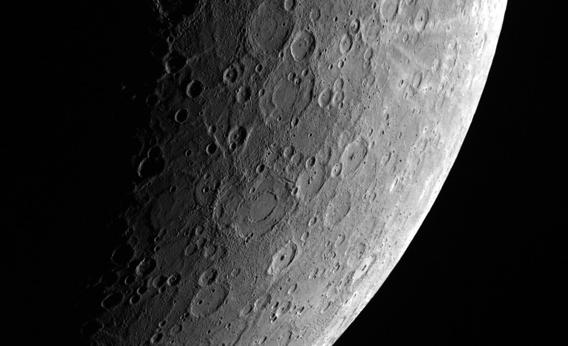Create a free profile to get unlimited access to exclusive videos, sweepstakes, and more!
Mercury’s Limb

I havenât posted a dramatic picture of Mercury from the Messenger (MErcury Surface, Space ENvironment, GEochemistry, and Ranging)Â spacecraft in a long timeânot since I moved to Slate, certainlyâand I really like this new one, shown above. This is the limb, or apparent edge, of the planet seen near the planetâs south pole from the orbiting spacecraft.
Funny how much it superficially looks like the Moon. Both are airless and rocky, so the color and cratering are similar. But even if you woke me out of a cold sleep, I could tell you thatâs not the Moon. I donât know why, exactly: Iâm familiar enough with the Moonâs surface but not so much that I could recognize any random spot.
But even so, these features are just different. The contrast is different than on the Moon, and the crater sizes donât seem to have the same distribution. Ignoring the craters, the surface also seems flatter than the Moon's, which is littered with hills and mountain chains and hummocks.
This shot of Mercury does show some neat features. The crater with rays, those liner streaks, is probably the most obvious. Thatâs Han Kan, a 50-kilometer (30-mile) wide impact crater. Rays are formed when plumes of material shoot out from the impact site and settle onto the surface. They wear away with time (erosion from micrometeorites, impact from the solar wind, and even the thermal stress of the extreme temperature difference between day and night contributes to that), so seeing a rayed crater indicates relative youth.
You can also see a couple of double-walled craters, like a crater in a crater. That sometimes forms in larger impacts, though the exact physics isnât completely understood. (Itâs hard to model a gigantic hypervelocity impact when youâre not exactly sure what all the physical processes going on happen to be.) The one just below center is Bachâhereâs a shot of it looking straight downâand a little to the north is Cervantes. You can spot more of them, too, if you look around. It helps to have an atlas.
Mercury is a very hard planet to observe from Earth; its orbit around the Sun is smaller, so it never gets very far from the star. That means itâs only up at dawn and dusk, so you donât get much time to view it before either it sets or the Sun rises. Youâre also always looking near our horizon, through our thick air, distorting and dimming the view. In other words, thereâs nothing like being there.
Weâve sent probes to the smallest planet in the past, but they were all âfly-byâ missions; Messenger was the first to orbit. Itâs been an amazing beast, withstanding the heat and radiation of the Sun for yearsâit went into orbit around Mercury in March 2011 after several years of travel to get there. The primary mission ended in 2012, but it was extended a year, and hopefully it will be extended again; weâre still awaiting word if it will get more time.
Obviously, I hope it does. Mercury is a fascinating little world, so familiar yet so strange. Itâs certainly worth taking more time to get a closer look.


























